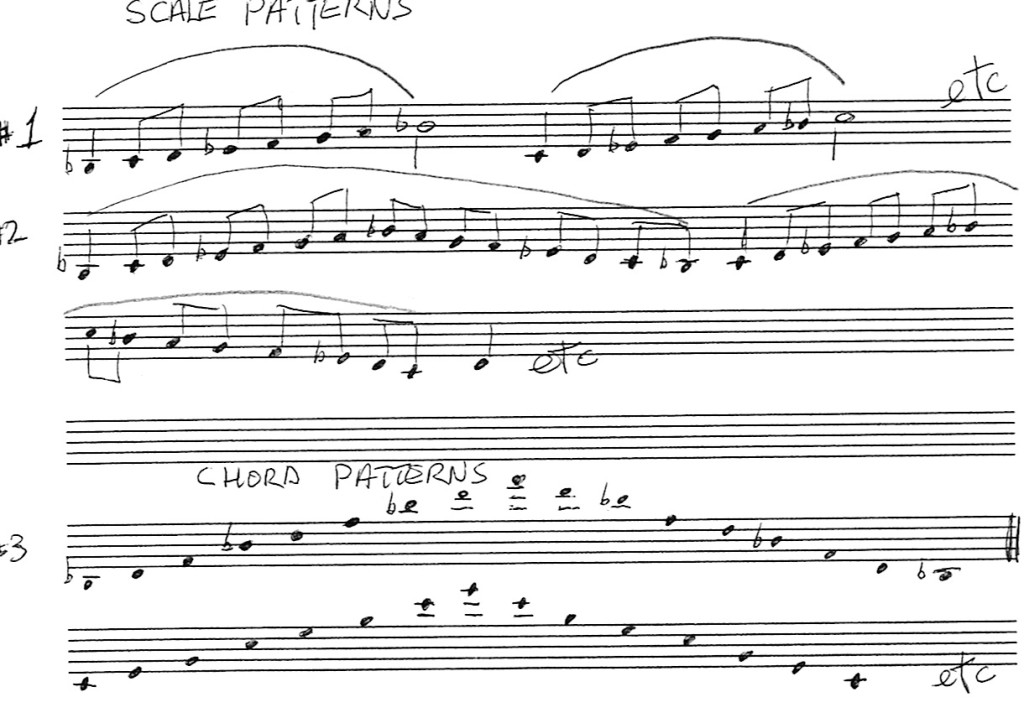Here’s Some Simple Exercises to Develop Saxophone Control and Tone
In this video:
- inherent sax problems
- 3 different Bb fingerings
- 2 different F fingerings
- exercises to develop full range control
Spend your daily saxophone practice time wisely. Follow these few and simple exercises to develop saxophone control and tone. There are a few inherent problem areas on a saxophone. Some of these can take some time to master and some can be a constant pain it the you-know-what!
One is the very low end of the horn… low Bb, B and sometimes even C and C#. A sax that has good, non-leaky pads, proper air support, and a good reed will fix this problem.
The 2nd problem is at the octave break, that’s middle C going to the D. This problem is mostly in our beginning stage of development and is mastered with good finger technique and air control.
The 3rd problem is the high register. This problem is worst on some saxophones than others… the soprano and bari can take some work to get your intonation bang-on up there, especially when starting out or switching over from alto or tenor.
Embouchure and good air support will eventually fix this problem. These areas will need to be worked on individually with a big focus before you can be fluent on your sax. By fluent I mean just being able to tear it up from top to bottom without stumbling on notes or breaking any of them… and keeping them all in tune as well.
This is a tall order when at the beginning to intermediate stages of saxophone playing. Don’t shy away from the top and bottom notes in your exercises… work on scales and chords that start on low Bb and go all the way up to high F.
Keep in mind to make every note even in length and volume. This is a very good exercise and when done right and will produce noticeable benefits in your playing almost immediately. There are numerous variations for scales and chords you can use… here’s a few to get you going:
These don’t need to be fancy, the point is to play in full control and be strong from top to bottom. Remember, you’ll improve faster if you record yourself doing these.
If you aren’t sure about the quality of your daily exercises, consider following a step-by-step guide I put together to help you do just that. This is my “guaranteed results” Daily Saxophone Practice Routine it may be just the guide you need to start seeing faster results from your daily practicing routine.
Good luck!
Johnny




For high F, the forked F is what I use 90% of the time because it’s much easier for me to go from high F to high F# and Altissimo G from the Forked F position; but there are times where using the side F is better, depending on what I’m playing. It sure pays to be able to use both of them. Same thing with the 3 different Bb fingerings. I really love hitting the 3rd Bb in my playing–I know it’s not considered the norm but it’s something I’ve gotten into the habit of doing more and more other than just the 2 standard Bb fingerings. I was wondering Johnny if you ever find yourself in situations that you use that 4th Bb fingering that you’ve taught us before?
@JF – i recently changed mouthpiece, and my Pro gave me a bunch of exercises and resighted my mouthpiece to get me playing in tune – RESULT in under 2 weeks. Without his exercises theres is no way i would be able to play in tune with the mouthpiece in that position, and be able to easily play all the keys up and down the sax in tune. I have’nt practicesed any overtones for 3 weeks like he insisted until i got his exerecises under control. Today i tried the overtones, and they were so much easier and stronger.
If everyone followed these simple exercises just like you are advocating – then theres no need, to change reeds, or change ligatures, or change mouthpieces, or change the surface of your mouthpiece,
A working sax, a 4c mouthpiece, a basic ligature, 1.5 reed and you’re good to go – with the right exercises in under a year a young student is playing in tune up and down the sax.
I’ve learnt the hard way – change and monkey about with the setup gets you nowhere – the secrets in the exercises.
nice one Jf – you set me on the road with yourdaily sax routine
yup, the basics do’t ever change much. a lot of people are constantly looking for short cuts and tricks but with the sax it’s gonna come down to some simple basics done right over a period of time….good you got a teacher, that’s one short cut that works!
Michael, personally I only use 2 fingerings for Bb; the side key and the bis key. I may try the other fingerings when I’m bored just so I don’t forget em!
Hi Johnny, talking about for me how the 3rd Bb fingering helps me out at times; an example is one of my uploads that is done/was ready was Smooth Operator by Sade. I decided to learn/play it on Tenor Sax and in the solo there’s a couple of licks where we play a Bb; especially in this solo the 3rd Bb fingering made the solo much easier for me to play. At some point after I’m fully healed I’m going to do Sade’s other song of “Your Love Is King” but I want to do that one on the Alto instead, would be very expressive on the Alto Sax. On a side note, the advice I got from my Orthopedic physician seems to be helping–the swelling in the Masseter Muscle has went down quite a bit and is almost back to normal size, but as with any pulled muscle I can still feel the soreness. But for the fact that the swelling has gone down has put me in a good mood and I’m in high hopes. The hardest thing right now is resisting the urge to pick up the Sax, easier said than done….I want to see how the muscle actually feels, but I just don’t want to risk having any kind of a relapse. Letting it heal naturally really seems to be helping, only time will tell.